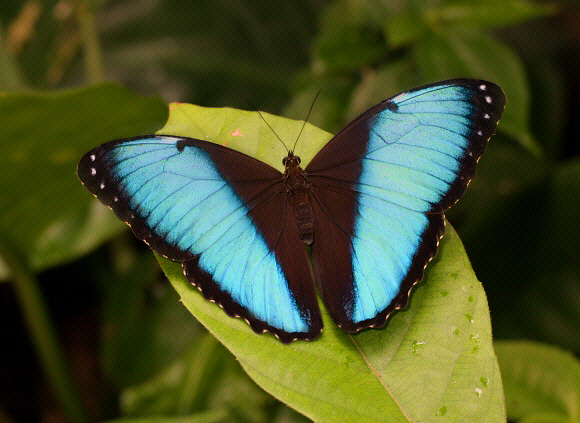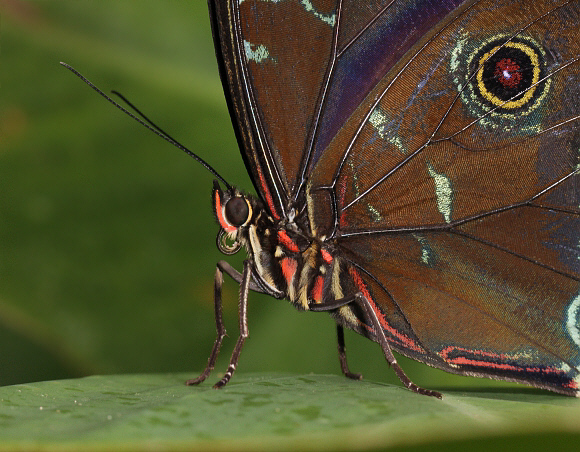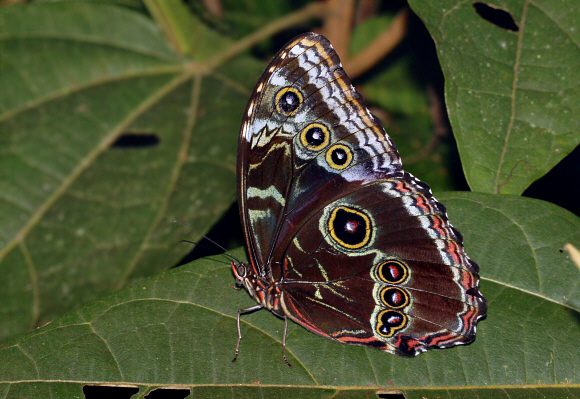
It is a source of amusement to lepidopterists that the general public in Latin America always refer to every one of the Morpho species as if they were just one creature – “the Blue Morpho”. There are in fact at least 29 described species, possibly more, as the status of some subspecies is contended by certain taxonomists who consider they should be elevated to the rank of full species. Older literature tends to list up to 80 species, but more recent phylogenetic research indicates that many of these are subspecies or forms. The former ‘species’ achillaena, montezuma and peleides for example are amongst the 30 taxa now listed by Lamas ( 2004 ) as subspecies of helenor.

Morpho helenor and its close relative achilles are recognised by the broad vertical bands of brilliant blue on their uppersides, and by the distinctive white, black, yellow and red concentric rings which form the ocelli on their olive-brown underside hindwings. The size of these ocelli, and the width of the blue bands on the upperside, varies considerably. Andrew Neild ( author of Butterflies of Venezuela ) describes the differences between helenor and achilles thus: “In helenor the submarginal whitish band on the underside hindwing widens towards the apex and is usually widest at the apex in achilles it narrows towards the apex, and is usually wider / widest in its mid section. Also, but not always, on the FW, in space 3 (the one that usually has the biggest FW ocellus), the broad pale band is almost always crescent-shaped. In achilles it is usually triangular, or if nearly crescent-shaped, wider than it is in sympatric helenor”.

The dazzling blue wings of Morpho butterflies are enormous relative to their body size, resulting in a very distinctive slow, bouncy flight pattern. The effect is that the brilliant blue upperside appears to flash like a beacon as it alternates in flight with the dark undersurface. This makes it difficult for a bird to follow the flight. If attacked when on the wing, the slow lazy flight pattern instantly changes into a wild swooping evasive manoeuvre, following which the butterfly dives into the forest where it instantly settles. A pursuing bird is still of course searching for a brilliant blue insect, but the Morpho snaps its wings shut, displaying the dark brown underside and foiling the bird’s search program. If the bird does manage to spot the settled butterfly it invariably aims its attack at the most prominent feature – in this case the ocelli, missing the body entirely and allowing the butterfly to escape. Morpho helenor is a widespread and common species found throughout the neotropical region from Mexico to Bolivia.
Habitats
This species is adapted to breed in a wide variety of forested habitats, occurring for example in dry deciduous woodlands at sea level in Guanacaste ( Costa Rica ) as well as in wet tropical forests and Andean cloudforest at altitudes of up to about 1800m.
Lifecycle
The domed egg is pale green with a narrow reddish ring near the top. It is laid singly on leaves of the food plants. The fully grown larva is plump, with a large head. The body is beautifully patterned with fine longitudinal lines of bright red, yellow and black, and covered with fine brown hairs which are tufted near the head and tail, and in the middle of the back. It feeds on Macharium, Swartzia, Lonchocarpus, Pterocarpus and Dalbergia – all trees in the family Fabaceae. Morpho larvae have eversible glands on the thorax which emit a strong odour as a defence against predators. The pupa is pale green and bulbous, with a short and sturdy peduncle, suspended from a stem.
Adult behavior
The bouncy zigzag flight of this saucer-sized butterfly is unmistakeable. Males patrol back and forth along the courses of streams in the dappled sunlight of their forest habitats. They are most active in the mornings, and spend the afternoons mud-puddling, feeding at rotting fruit or at sap runs or sitting motionless on foliage in light gaps.
Females are recognised by the wider dark borders on the uppersides. They are seen far less often, usually only in late morning when they fly along trails, resting regularly amongst vegetation.
Both sexes close their wings immediately upon landing, but periodically flick them open to give the briefest glimpse of the dazzling blue upperside. This behaviour is most pronounced in mud-puddling males, which repeatedly flicker their wings as they hop about on the ground seeking dissolved minerals.
